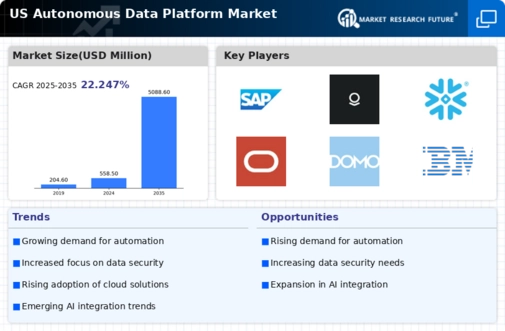Integration of Cloud Technologies
The integration of cloud technologies significantly influences the autonomous data-platform market. As organizations migrate to cloud-based solutions, the demand for scalable and flexible data platforms increases. In 2025, cloud adoption in the US is projected to reach 85%, with businesses prioritizing cloud-native architectures for their data management needs. This shift allows for enhanced collaboration, improved data accessibility, and cost efficiency. Consequently, the autonomous data-platform market is poised to benefit from this trend, as companies seek platforms that seamlessly integrate with their cloud environments, enabling them to leverage data more effectively.
Rising Demand for Data-Driven Insights
The autonomous data-platform market experiences a notable surge in demand for data-driven insights across various sectors. Organizations increasingly recognize the value of leveraging data analytics to enhance decision-making processes. In 2025, it is estimated that the market for data analytics solutions will reach approximately $200 billion in the US, indicating a robust growth trajectory. This trend is driven by the need for businesses to remain competitive and agile in a rapidly evolving landscape. As companies seek to harness the power of data, the autonomous data-platform market becomes essential in providing the necessary infrastructure and tools to facilitate this transformation.
Growing Regulatory Compliance Requirements
The autonomous data-platform market is increasingly shaped by the growing regulatory compliance requirements across various industries. Organizations are compelled to adhere to stringent data protection regulations, such as the CCPA and GDPR, which necessitate robust data governance frameworks. In 2025, it is anticipated that compliance-related expenditures will account for approximately 15% of IT budgets in the US. This trend drives the demand for autonomous data platforms that offer built-in compliance features, ensuring that organizations can manage their data responsibly while minimizing risks associated with non-compliance.
Emphasis on Enhanced Data Security Measures
The emphasis on enhanced data security measures significantly impacts the autonomous data-platform market. With the rise in cyber threats and data breaches, organizations are prioritizing the implementation of robust security protocols to protect sensitive information. In 2025, it is projected that cybersecurity spending in the US will exceed $200 billion, highlighting the critical need for secure data management solutions. This trend drives the demand for autonomous data platforms that incorporate advanced security features, such as encryption and access controls, ensuring that organizations can safeguard their data assets while maintaining compliance with industry standards.
Advancements in Data Processing Technologies
Advancements in data processing technologies play a crucial role in the evolution of the autonomous data-platform market. Innovations such as edge computing and distributed ledger technology enable organizations to process vast amounts of data in real-time. In 2025, the market for edge computing is expected to reach $50 billion in the US, reflecting a growing preference for decentralized data processing solutions. These advancements empower businesses to derive insights more quickly and efficiently, thereby enhancing their operational capabilities. As a result, the autonomous data-platform market is likely to see increased adoption of these cutting-edge technologies.
























Leave a Comment